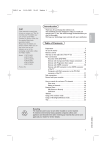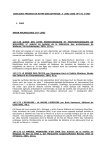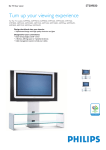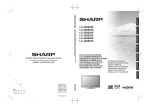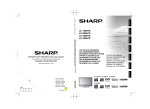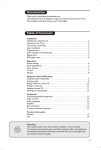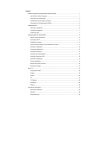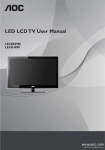Download Philips 37PF7320A Flat Panel Television User Manual
Transcript
10:15 Pagina 1 Introduction Thank you for purchasing this television set. This handbook has been designed to help you install and operate your TV set. We would strongly recommend that you read it thoroughly. We hope our technology meets entirely with your satisfaction. Table of Contents English 05-10-2005 Deutsch 2440.2 gb . . . . . . . . . . . . . . . . . . . . . . . . . . . . . . . . . . . . . . . . . . . . . . . . . . . . . . . . . . . . . . . . . . . . . . . . . . . . . . . . . . . . . . . . . . .2 .3 .5 .5 .6 .6 Operation Picture settings . . . . . . . . . . . . . . . . . . . . . . . . . . . . . . . . . .7 Sound adjustments . . . . . . . . . . . . . . . . . . . . . . . . . . . . . . .7 Feature settings . . . . . . . . . . . . . . . . . . . . . . . . . . . . . . . . .7 Teletext . . . . . . . . . . . . . . . . . . . . . . . . . . . . . . . . . . . . . . .8 Using in PC monitor mode . . . . . . . . . . . . . . . . . . . . . . . . .9 Using in HD mode . . . . . . . . . . . . . . . . . . . . . . . . . . . . . .10 The keys on the right side of the TV set . . . . . . . . . . . . .10 Peripherals To select connected equipment Video recorder . . . . . . . . . . . . Other equipment . . . . . . . . . . Side connections . . . . . . . . . . Computer . . . . . . . . . . . . . . . . Video recorder and DVD keys . . . . . . . . . . . . . . . . . . . . . . . . . . . . . . . . . . . . . . . . . . . . . . . . . . . . . . . . . . . . . . . . . . . . . . . . . . . . . . . . . . . . . . . . . . . . . . . . . . . . . . . . . . . . . . . . . . . . . . . .11 .11 .12 .12 .12 .13 Practical information ∂ÏÏËÓÈο Tips . . . . . . . . . . . . . . . . . . . . . . . . . . . . . . . . . . . . . . . . .14 Glossary . . . . . . . . . . . . . . . . . . . . . . . . . . . . . . . . . . . . . .14 Nederlands . . . . . . Italaino . . . . . . Español . . . . . . Português . . . . . Recycling R The packaging of this product is intended to be recycled. Apply to the local authorities for correct disposal. Disposal of your old product Your product is designed and manufactured with highly quality material and components, which can be recycled and reused. When this crossed-out wheeled bin symbol is attached to a product, it means the product is covered by the European Directive 2002/976/EC. Please inform yourself about the local separate collection system for electrical and electronic products. Please act according to your local rules and do not dispose of your old products with your normal household waste.The correct disposal of your old product will help prevent potential negative consequences for the environment and human health. 1 Türkce Model: 37PF7320 42PF7320 42PF7420 37PF5320 42PF5320 Product No: Preparation . . . . . . . . . . . . . . . . . Remote control . . . . . . . . . . . . Quick installation . . . . . . . . . . . . Program sort . . . . . . . . . . . . . . . Manual store . . . . . . . . . . . . . . . Other settings in the Install menu 3104 315 2440.2 Help? If this instruction manual does not give an answer or if ‘Tips’ do not solve your TV problem, you can call your Local Philips Customer or Service Centre. See the supplied World-wide guarantee booklet. Please, have the Model and Product number which you can find at the back of your television set or on the packaging, ready, before calling the Philips helpline. Français Installation 2440.2 gb 05-10-2005 10:15 Pagina 2 Care of the screen Do not touch, push or rub or strike the screen with anything hard as this may scratch, mar or damage the screen permanently. Do not rub with dust clothes with chemical treatment. Do not touch the surface with bare hands or greasy cloth (some cosmetics are detrimental to the screen). Unplug the TV before cleaning the screen. When the surface becomes dusty, please wipe gently with absorbent cotton or other soft materials like chamois soaks. Do not use acetone, toluene and alcohol because they cause chemical damage. Do not use liquid cleaners or aerosol cleaners. Wipe off saliva or water drops as soon as possible. Their long time contact with the screen causes deformations and colour fading. Warning concerning stationary images on the TV screen A characteristic of Plasma Display Panels is that displaying the same image for a long time can cause a permanent after-image to remain on the screen. This is called phosphor burn in. Normal use of the TV should involve the showing of pictures that contain constantly moving and changing images that fill the screen. Preparation & Table stand instructions How to mount the supplied stand, see the supplied Quick Start Guide. Note: Other (not supplied) stands are optional accessories. Consult your dealer. é For ventilation, leave at least 5 cm free all around the TV. To prevent any unsafe situations, no naked flame sources, such as lighted candles, should be placed in the vicinity. Avoid heat, direct sunlight and exposure to rain or water. The equipment shall not be exposed to dripping or splashing. “ Insert the aerial plug firmly into the aerial socket x at the bottom of the TV. For best picture quality use the suppressoraerial cable supplied. ‘ Insert the mains cord supplied into the mains at the bottom of the TV and in the wall socket having a mains voltage of 220-240V 50/60Hz. To prevent damaging the power (AC) cord which could cause a fire or electric shock, do not place the TV on the cord. 2 ( Remote control: Pull out the plastic insulation sheet from the battery, this will activate the remote control. CR 2025 The battery supplied with the appliance does not contain mercury or nickel cadmium so as to protect the environment. Please do not discard your used batteries, but use the recycling methods available (consult your distributor). § To switch on the set, press the B key on the TV. An indicator comes on and the screen lights up. Go straight to the Quick Installation chapter, p. 5. If the TV remains in standby mode (red indicator), press the -P+ key on the remote control. The indicator will flash when you use the remote control. 2440.2 gb 05-10-2005 10:15 Pagina 3 x Pixel Plus demo on/off (Only available on certain versions.) • Press the x key. The screen is divided into 2 parts: - in the left part Pixel Plus is switched off; - In the right part Pixel Plus is switched on. • Press the x key again to switch the Pixel Plus demo off. ®Ò‡π† Video recorder or DVD keys. See p. 13. Q Surround mode Virtual Dolby* Surround Optimal with Dolby surround signals. Enables you to experience the effect of Dolby surround Pro Logic, reproducing a rear sound effect. See Sound menu, Dolby Virtual, p. 7. Note:You can make the same selection in the Sound menu, p. 7. AV To display the Source list to select TV or peripheral equipment connected to EXT1, EXT2/SVHS2, AV/SVHS3, PC or HD. See also p. 11. h Active control Optimizes the picture quality depending on the quality of the incoming signal. Press this key to switch between On, On with sensor and Off. MENU To call up or exit the menus. Cursor keys Press the keys oœpπ to navigate through the menus. VOL To adjust the volume. 0/9 Digit keys For direct access to programmes. For a two digit programme number, enter the second digit before the dash disappears. English Use of the remote control B Standby Press to switch the TV on or off. æPIP (Picture in Picture) on/off (p. 10) ı List of programmes To display/clear the list of programmes. Use the keys oœ to select a programme and the key π to display it. X Sound mode Used to force programmes in Stereo and Nicam Stereo to Mono or, for bilingual programmes, to choose between Dual I or Dual II. The Mono indication is red when in forced position. f:gb Teletext Teletext functions. See p. 8. OK Only applicable for DVD or AUX mode. See p. 13. ¬ Interrupt the sound or restore it. Smart picture a and sound M Used to access a series of predefined picture and sound settings. This Philips TV has been set at the factory to look best in bright store environments which use fluorescent lighting. As your home will likely not be as well lit as a store, we recommend you that you cycle through the various smart picture modes to find the one that best stuits your own viewing conditions. Most consumers will find that Natural is the correct choice. P Programme selection To move up or down a programme. The number and the sound modes are displayed for a few seconds. For some TV programmes the title of the programme appears at the bottom of the screen. 0 Previous TV channel * Dolby’ ‘Pro Logic’ and the double-D G symbol are trademarks of Dolby Laboratories Licensing Corporation. Manufactured under license from Dolby Laboratories Licensing Corporation. Press to display the previously selected TV channel. 3 2440.2 gb 05-10-2005 10:15 Pagina 4 MODE* Press this key to switch between TV, DVD and AUX. q 16:9 formats The pictures you receive may be transmitted in 16:9 format (wide screen) or 4:3 format (conventional screen). 4:3 picture sometimes have a black band at the top and the bottom of the screen (letterbox format). This function allows you to optimise the picture display on screen. Using the different formats Press the q key or use the keys pπ to select the different modes: 4:3, Movie Expand 14:9, Movie Expand 16:9, Subtitle Zoom, Superzoom and Widescreen. 4:3 The picture is reproduced in 4:3 format and a black band is displayed on either side of the picture. Movie Expand 14:9 The picture is enlarged to 14:9 format, a thin black band remains on both sides of the picture. Movie Expand 16:9 The picture is enlarged to 16:9 format.This mode is recommended when displaying pictures which have black bands at the top and bottom (letterbox format). Subtitle Zoom This mode is used to display 4:3 pictures using the full surface of the screen leaving the subtitles visible. Superzoom This mode is used to display 4:3 pictures using the full surface of the screen by enlarging the sides of the picture. Widescreen This mode restores the correct proportions of pictures transmitted in 16:9 using the full screen display. Note: If you display a 4:3 picture in this mode, it will be enlarged horizontally. i Screen information Press to display information (when available) about the selected TV channel and programme. Hold down for 5 seconds to permanently display the programme number on the screen. * Mode selector The remote control lets you control the main functions of the VCR or DVD. Press the MODE key to select the required mode: DVD or AUX (VCR). The remote control indicator lights up to display the selected mode. It switches off automatically after 20 seconds if left idle.The remote control automatically returns to TV mode. The following keys are operational, depending on the equipment (see p. 13): B, X, ®Ò‡π†, OK, MENU, cursor keys, -P+, digit keys, i, 0. 4 2440.2 gb 05-10-2005 10:15 Pagina 5 When you turn on the TV set for the first time, a menu is displayed on screen.This menu prompts you to select the country and language for the menus: Plug’n’Play Country Language GB English If the menu is not displayed, press the MENU key to display the menu. & Use the keys oœ on the remote control to select your country and validate with π. If your country does not appear in the list, select choice “. . .” é Next select your language using the keys oœ and validate with π. “ The search starts automatically. All the available TV programmes will be stored. This operation takes a few minutes.The display shows the progress of the search and the number of programs found. At the end of the search, the menu disappears. To exit or interrupt the search, press the MENU key. If no programme is found, consult the possible solutions. See Tips, p. 14. ‘ ATS (Automatic Tuning System): If the transmitter or cable network sends the automatic sort signal, the programs will be numbered correctly. In this case, the installation is complete. If this is not the case, you need to use the Sort menu to number the programs correctly. ( ACI (Automatic Channel Installation): If a cable system or a TV channel which broadcasts ACI is detected, a programme list appears.Without ACI broadcast, the channels are numbered according your language and country selection.You can use the Sort menu to renumber them. Some transmitters or cable networks broadcast their own sort parameters (region, language, etc.). In this case, indicate your choice using the keys oœ and validate with π. Program Sort & Press the MENU key. é With the cursor, select the Install menu The TV menu is displayed on the screen. followed by the Sort menu. “ Select the programme you want to move using TV Menu Picture Sound Features Install the keys oœ and press π. Install Language Country Auto Store Manual Store Sort Name Æ Æ Æ Æ Æ Æ • • • • • • 0 1 2 3 4 5 ‘ Then use the keys oœ to select the new number and validate with cursor p. ( Repeat steps “ and ‘ for each program you wish to renumber. § To quit the menus, press the i key. 5 English Quick installation 2440.2 gb 05-10-2005 10:15 Pagina 6 Manual Store This menu is used to store the programmes one at a time. & Press the MENU key. é With the cursor, select the Install menu then Manual store. TV Menu Picture Sound Features Install Manual Store System Search Program No. Fine Tune Store Europe “ System: select Europe (automatic detection*) or Western Europe (BG standard), Eastern Europe (DK standard), United Kingdom (I standard) or France (LL’ standard). * Except for France (LL’ standard), you must select choice France. ‘ Search: press π.The search starts. Once a programme is found, the scanning stops and its name is displayed (when available). Go to the next step. If you know the frequency of the required programme, this can be entered directly using the digit keys. If no picture is found, consult Tips, p. 14. ( Program No.: enter the required number with the keys pπ or with the digit keys. § Fine Tune: if the reception is not satisfactory, adjust using the keys pπ. è Store: press π.The programme is stored. ! Repeat steps ‘ to è for each programme to store. ç To quit the menus, press the i key. Other settings in the Install menu & Press the MENU key and select the Install menu. é Language: to change the display language for the menus. “ Country: to select your country (GB for Great Britain). This setting is used for the search, automatic programme sort and teletext display. If your country does not appear in the list, select “. . .” ‘ Auto Store: to start automatic search for all programmes available in your region. If the transmitter or cable network sends the automatic sort signal, the programmes will be numbered correctly. If this is not the case, you need to use the Sort menu to renumber the programmes (see p. 5). Some transmitters or cable networks broadcast their own sort parameters (region, language, etc.). In this case, indicate your choice using the keys oœ and validate with π. To quit or interrupt the search, press the MENU key. If no picture is found, consult Tips, p. 14. 6 ( Name: If required, you can give a name to the programmes and external connectors. Use the keys oœ to move around the name display area (5 characters) and the keys pπ to select the characters.When the name has been entered, use the key p to exit.The name is stored. Note: on installation, the programs are named automatically when an identification signal is sent. § To quit the menus, press the i key. 2440.2 gb 05-10-2005 10:15 Pagina 7 & Press the MENU key then π. The Picture menu is displayed. Picture TV Menu Picture Sound Features Install Brightness Colour Contrast Sharpness Colour Temp. Store 39 é Use the keys oœ to select a setting and the keys pπ to adjust. Description of the adjustments: • Brightness: this changes picture brilliance. • Colour: this changes the intensity of the colour. • Contrast: this changes the difference between the light and dark tones. • Sharpness: this changes the picture definition. • Colour Temp.: this changes the colour rendering: Cool (bluer), Normal (balanced) or Warm (redder). • Store: to store the picture adjustments and settings. “ Once the adjustments have been made, select Store and press π to store them. Press the i key to exit. Sound adjustments & Press MENU, select Sound (œ) and press π. The Sound menu is displayed. TV Menu Picture Sound Features Install Sound Equalizer Balance Delta Volume AVL Dolby Virtual Store Æ Æ Æ Æ Æ Æ • • • • • • 120 Hz 500 Hz 1500 Hz 5 KHz 10 KHz é Use the keys oœ to select a setting and the keys pπ to adjust. “ Once the adjustments have been made, select Store and press π to store these changes. To store Equalizer settings, press MENU, select Store and press π. Description of the settings: • Equalizer: to adjust the sound tone (from bass: 120 Hz to treble: 10 kHz). • Balance: this balances the sound on the left and right speakers. • Delta Volume: this is used to compensate any volume discrepancies between the different programs or EXT sockets.This setting is available for programs 0 to 40 and the EXT sockets. • AVL (Automatic Volume Leveller): this is used to limit increases in sound, especially on program change or advertising slots. • Dolby Virtual:To activate/deactivate the surround sound effect You can also access these settings with the Q key. • Store: this is used to store the sound settings. ‘ To quit the menus, press the i key. Feature settings & Press MENU, select Features (œ) and press π. TV Menu Picture Sound Features Install Features Contrast+ NR Sleep PIP Æ Æ Æ Æ • • • • é You can adjust: • Contrast +: automatic adjustment of the picture contrast which permanently sets the darkest part of the picture to black. • NR: attenuates picture noise (snow) in difficult reception conditions. • Sleep (Only available on certain versions): to select an automatic standby period. • PIP: to adjust the size and position of the PIP screen. “ To quit the menus, press the i key. 7 English Picture settings 2440.2 gb 05-10-2005 10:15 Pagina 8 Teletext Teletext is an information system broadcast by certain channels which can be consulted like a newspaper. It also offers access to subtitles for viewers with hearing problems or who are not familiar with the transmission language (cable networks, satellite channels, etc.). Press: b Teletext on/off This is used to call teletext, and then exit. The summary appears with a list of items that can be accessed. Each item has a corresponding 3 digit page number. If the channel selected does not broadcast teletext, the indication 100 will be displayed and the screen will remain blank (in this case, exit teletext and select another channel). 0/9 -P+ Selecting a page Enter the number of the page required using the 0 to 9 or -P+ keys. Example: page 120, enter 1 2 0. The number is displayed top left, the counter turns and then the page is displayed. Repeat this operation to view another page. If the counter continues to search, this means that the page is not transmitted. Select another number. OOOO Direct access to the items Coloured areas are displayed at the bottom of the screen. The 4 coloured keys are used to access the items or corresponding pages. The coloured areas flash when the item or the page is not yet available. i Contents This returns you to the contents page (usually page 100). Enlarge a page This allows you to display the top or bottom part of the page and then return to normal size. g Stop subpage acquisition Certain pages contain subpages which are automatically displayed successively.This key is used to stop or resume subpage acquisition.The indication _ appears top left. : Double page teletext cursor oœ X MENU OOOO i 8 You will obtain: Favourite pages To activate or deactivate the double page teletext display mode.The active page is displayed on the left and the following page is displayed on the right. Press g if you want to hold a page (i.e. the contents page).The active page is then displayed on the right.To return to normal mode, press X. Instead of the standard coloured areas displayed at the bottom of the screen, you can store 4 favourite pages on the first 40 channels which can then be accessed using the coloured keys (red, green, yellow, blue). Once set, these favourite pages will become the default every time teletext is selected. & Press the MENU key to change the favourite pages mode. é Display the teletext page that you want to store. “ Press the coloured key of your choice for 5 seconds. The page is stored. ‘ Repeat steps é to “ for the other coloured keys. ( Now when you consult teletext, your favourite pages will appear in colour at the bottom of the screen; to temporally retrieve the standard items, press MENU. To clear everything and return to the standard items as the default, press i for 5 seconds. 2440.2 gb 05-10-2005 10:15 Pagina 9 Should your remote be lost or broken you can still change some of the basic settings with the keys on the right side of your TV. + VOLUME - MENU/OK + PROGRAM - POWER Press: • POWER : to switch the TV on or off. • + VOLUME - : to adjust sound level. • + PROGRAM - : to select programmes. • MENU : to access or close menus. The + PROGRAM - keys can be used to select an adjustment and the + VOLUME - keys to make that adjustment. Using in PC monitor mode NOTE - When using your TV as a PC monitor, slight diagonal interference lines may be observed when it is operated under electromagnetic interference environment but will not affect the performance of this product. - For better performance, good quality DVI/VGA cable with good noise isolation filter is recommended. Your TV can be used as a computer monitor. Note:You must first of all connect the computer and adjust the resolution (see p.12). Audio selection To choose the sound reproduced on the TV (PC or TV). & Press the AV key on the remote control to Features • Phase/Clock*: eliminates the horizontal (Phase) and vertical (Clock) interfering lines. • Format: to choose between Full screen or Native format. • PIP: to adjust the size and position of the PIP screen. • Auto adjust*: position is set automatically. display the Source list. é Use the keys oœ to select PC and then press π to switch the TV to PC mode (DVI). “ To return to TV mode, repeat steps & and é, but select TV instead. Using the PC menus Press the MENU key to access the specific settings of the PC monitor mode. Use the cursor to adjust them (the settings are automatically saved): Picture • Brightness/Contrast: to adjust the brightness and contrast. • Horizontal/Vertical*: to adjust the horizontal and vertical placing of the image. • Colour Temp: to adjust the colours (cool, normal or warm). Reset to Factory To return to the factory settings (default settings). * These adjustments are not available when a computer is connected to the DVI input. 9 English Keys on the right side of the TV 2440.2 gb 05-10-2005 10:15 Pagina 10 Using in HD (High Definition) mode The HD (High Definition) mode allows you to enjoy clearer and sharper pictures through the DVI inputs if you are using a HD receiver/ equipment that can transmit high definition programming. You must first of all connect the HD equipment (see p.12). & Press the AV key on the remote control to display the Source list. é Use the keys oœ to select HD and then press π to switch the TV to HD mode. “ To return to TV mode, repeat steps & and é, but select TV instead. Using the HD menus Press the MENU key to access the specific settings of the HD mode. Use the cursor to adjust them (the settings are automatically saved): Picture • Brightness: this changes picture brilliance. • Colour: this changes the intensity of the colour. • Contrast: this changes the difference between the light and dark tones. • Sharpness: this changes the picture definitions. • Colour Temp.: this changes the colour rendering: Cool (more blue), Normal (balanced) or Warm (more red). • Store: to store the picture adjustments and settings. Using PIP in PC and HD mode Sound • Equalizer: to adjust the sound tone (from bass 120 Hz to treble 10 kHz). • Balance: this balances the sound on the left and right speakers. • Delta Volume: this is used to compensate any volume discrepancies between the different programmes or EXT sockets.This setting is available for programmes 0 to 40 and the EXT sockets. • AVL (Automatic Volume Leveler): this is used to limit increases in sound, especially on programme change or advertising slots. • Dolby Virtual: to activate/deactivate the surround sound effects. You can also access these settings with the Q key. • Store: this is used to store the sound settings. Features • Sleep: to select an automatic standby period. • PIP: to adjust the size and position of the PIP screen. • Horizontal shift: adjust the horizontal placing of the image; (Only available on certain versions) While in PC or HD mode you can call up a window for TV channels. The PIP function lets you display a superimposed image to watch the TV channels at the same time. Attention: The PIP feature is only available if a computer or HD device is connected to the DVI input and if your PC or HD device has a digital output (DVI OUT to DVI IN). See p. 12. & Press the æ key to display the PIP screen. The television image is reproduced in a small superimposed window. é Subsequent presses of the æ key changes the size of the window, switches to dual screen and turns PIP off. “ Use the -P+ keys to change the programmes of the PIP screen. Note: No audio selection possible in HD PIP mode. 10 2440.2 gb 05-10-2005 10:15 Pagina 11 The television has 3 external sockets situated at the back of the set (EXT1, EXT2 and DVI) and sockets on the side. Press the AV key on the remote control to display the Source list and select TV or peripheral equipment connected to EXT1, EXT2/SHVS2, AV/SVHS3, PC or HD. The EXT1 socket has audio, CVBS/RGB inputs and audio, CVBS outputs. The EXT2 socket has audio, CVBS/S-VHS inputs and audio, CVBS outputs. The side connections has audio inputs, CVBS/S-VHS inputs, headphone out. EXT 2 DVI EXT 1 AUDIO ANTENNA 75 IN IN Video recorder CABLE EXT 1 ANTENNA EXT 1 EXT 2 DVI 75 AUDIO RECORDER DECODER Other equipment EXT 1 EXT 1 EXT 2 DVI AUDIO ANTENNA Carry out the connections shown opposite, using a good quality euroconnector cable. If your video recorder does not have a euroconnector socket, the only connection possible is via the aerial cable.You will therefore need to tune in your video recorder's test signal and assign it programme number 0 (refer to manual store, p. 5). To reproduce the video recorder picture, press 0. Video recorder with decoder Connect the decoder to the second euroconnector socket of the video recorder.You will then be able to record scrambled transmissions. Satellite receiver, DVD, decoder, CDV, games, etc. Carry out the connections shown opposite. Connect the equipment (digital decoder, games, video recorders, certain DVD drives (with RGB)) and other equipment to EXT1. 75 To select connected equipment Press the AV key on the remote control to select EXT1. 11 English Connecting Peripheral Equipment 2440.2 gb 05-10-2005 10:15 Side connections Make the connections as shown opposite. With the AV key, select AV/SVHS3. For a mono set, connect the sound signal to the AUDIO L (or AUDIO R) input. The sound automatically comes out of the left and right speakers of the set. Headphones The - VOLUME + keys are used to adjust the volume level. The headphone impedance must be between 32 and 600 Ohms. IN IN id LC04 Pagina 12 05 DVI connector DVI AUDIO DVI AUDIO EXT 2 EXT 1 ANTENNA 75 1 The DVI connector allows the following TV and monitor display modes: EDTV 640 x 480i HD SDTV 640 x 480p 720 x 576p HDTV 1920 x 1080i 1280 x 720p VGA 640 x 480 60, 67, 72, 75 Hz PC SVGA 800 x 600 56, 60, 72, 75 Hz XGA 1024 x 768 60, 70, 75 Hz 2 .... .... Note: Configure the computer on 1024 x 768, 60 Hz for optimum resolution. If necessary, you can adjust the picture position to the centre of the screen with the keys pπ, oœ. & Select the type of connector of the device (DVD, HDTV, STB, PC, ...) you want to connect with the DVI connector of your TV. Connector type: Device: DVD HDTV STB YPbPr / HD-A VGA DVI digital stream DVD with YPbPr --- Euro 1080i --- (future) --- PC PC Computer DVD with DVI DVI (supplied only with certain versions) VGA é If necessary, use an appropriate adapter. Connector type: Device: Adapter (cable) YPbPr VGA DVI digital stream 3 cinch to VGA cable VGA to DVI + VGA to DVI “ Connect your device with the DVI connector at the bottom of YPbPr 12 the TV. ‘ Connect the audio cable to the DVI AUDIO input of the TV. 2440.2 gb 05-10-2005 10:15 Pagina 13 The remote control lets you control the main functions of the VCR of DVD. Press the MODE key to select the required mode: DVD or AUX (video recorder). The remote control indicator lights up to display the selected mode. It switched off automatically after 20 seconds if left idle. The remote control automatically returns to TV mode. The following keys are operational, depending on the equipment: B Ò † ® º ‡ π standby fast rewind fast forward recording pause stop play MENU menu cursor cursor navigation and adjustments OK validation 0-9 digit entry -P+ programme selection i OSD menu 0 T-C function (DVD); index function (VCR) The remote control is compatible with all Philips AV equipment using the RC5 standard and all DVDs using the RC6 standard. Your TV is equipped with a Kensington Security Slot, to prevent it from getting stolen. An anti-theft Kensington lock has to be purchased separately. The Kensington lock is a plastic-coated steel cable with a lock. One end has to be fixed to the opening of the TV and locked with a special key.The other end is attached to a fixed point. ® Kensington and MicroSaver are registred US trademarks of ACCO World Corporation with issued registrations and pending applications in other countries throughout the world. All other registred and unregistered trademarks are the property of their respective owners. 13 English Video recorder or DVD keys 2440.2 gb 05-10-2005 10:15 Pagina 14 Tips Poor reception The proximity of mountains or high buildings may be responsible for ghost pictures, echoing or shadows. In this case, try manually adjusting your picture: see Fine Tune (p. 6) or modify the orientation of the outside aerial. If you are using an indoor aerial, reception may be difficult in certain conditions.You can improve reception by rotating the aerial. If the reception remains poor, you will need to use an external aerial. No picture Have you connected the aerial socket properly? Have you chosen the right system? (p. 6). Poorly connected euroconnector cables or aerial sockets are often the cause of picture or sound problems (sometimes the connectors can become half disconnected if the TV set is moved or turned). Check all connections. Digital distortion The low quality of some digital picture material may be the cause of digital image distortion. In this case select the Soft setting using the Smart picture key a on the remote control. If on certain channels you receive a picture but no sound, this means that you do not have the correct TV system. Modify the System setting (p. 6). The amplifier connected to the TV does not deliver any sound? Check that you have not confused the audio output with the audio input. No sound PC and PIP modes Check that you have configured the computer on a compatible display resolution don’t work ? (see p. 12). Remote control The TV set does not react to the remote control; the indicator on the set no longer flashes when you use the remote control? Replace the battery. Standby If the set receives no signal for 15 mins, it automatically goes into standby mode. To save power, your set is fitted with components that give it a very low power consumption when in standby mode (less than 1 W). Cleaning the set Only use a clean, soft and lint-free cloth to clean the screen and the casing of your set. Do not use alcohol-based or solvent-based products. Still no results? Disconnect the mains plug of the TV for 30 seconds then reconnect it. If your TV set breaks down, never attempt to repair it yourself: contact your dealer's after-sales service. Tips Glossary DVI (Digital Visual Interface): A digital interface standard created by the Digital Display Working Group (DDWG) to convert analog signals into digital signals to accommodate both analog and digital monitors. This provides better picture quality than with standard video (VHS and 8 mm) where the Y/C signals are combined to provide only one video signal. NICAM sound: Process by which digital sound VGA (Video Graphics Array): a common standard graphics display system for PCs. can be transmitted. System:Television pictures are not broadcast in RGB signals:These are the three video signals, Red Green Blue, which make up the picture. Using these signals improves picture quality. S-VHS Signals:These are 2 separate Y/C video signals from the S-VHS and Hi-8 recording standards.The luminance signals Y (black and white) and chrominance signals C (colour) are recorded separately on the tape. 14 the same way in all countries.There are different standards: BG, DK, I, and L L’.The System setting (p. 5) is used to select these different standards.This is not to be confused with PAL or SECAM colour coding. Pal is used in most countries in Europe, Secam in France, Russia and most African countries.The inputs EXT1 and EXT2 are used to read NTSC coded recordings.














